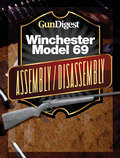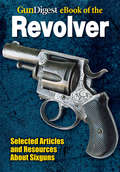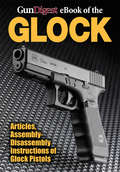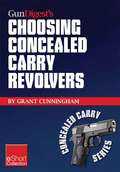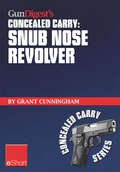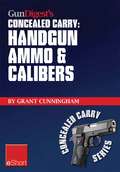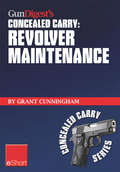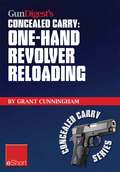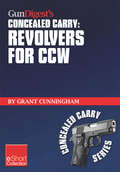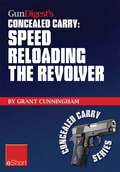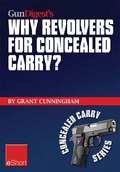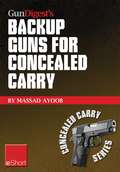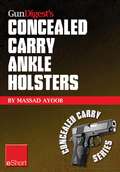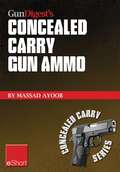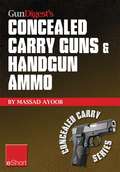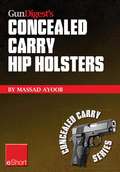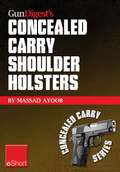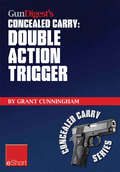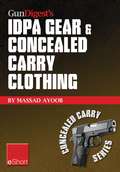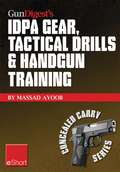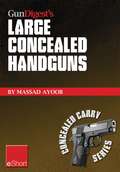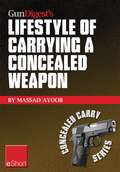- Table View
- List View
Gun Digest Winchester 69 Assembly/Disassembly Instructions
by Kevin MuramatsuThis short eBook teaches you how to take apart and reassemble your Winchester 69 with confidence. Thanks to clear Assembly/Disassembly instructions and crisp photography - aided by gun expert J.B. Wood's sage advice - you'll save an expensive trip to the gunsmith by getting to know your gun inside and out!
Gun Digest eBook of Revolvers
by Dan ShidelerThis e-book contains 16 in-depth chapters on all different kinds of revolvers, both new and old. Learn about the 38 S&W, 44 Special, 45 Auto Rimfire, Bull Dogs, cap and ball sixgunning, Colt and Smith & Wesson Police, the French Service Revolvers, the Ruger Super Blackhawk, the Webleys and more. If you're a sixgunner, this is your eBook.
Gun Digest eBook of the Glock
by Gun DigestThis short e-book contains six chapters by Gun Digest's top experts - including Jerry Ahern and Massad Ayoob - on the popular Glock semi-automatic pistol. Includes gun tests, history, overview, facts and tips for buying, selling, shooting and maintaining the Glock.
Gun Digest's Choosing Concealed Carry Revolvers eShort Collection
by Grant CunninghamIn this excerpt from the Gun Digest Book of the Revolver, Grant Cunningham compares revolvers with semi-autos, details the pros and cons of each and helps you choose the best revolver for CCW.
Gun Digest's Concealed Carry - Snub Nose Revolver
by Grant CunninghamIn this excerpt from the Gun Digest Book of the Revolver, Grant Cunningham teaches you how to control recoil in small snubnose revolvers for better accuracy. Also covered are grips and sights for snubnose pistols.
Gun Digest's Concealed Carry: Handgun Ammo & Calibers eShort
by Grant CunninghamIn this excerpt from the Gun Digest Book of the Revolver, Grant Cunningham explains the best calibers and handgun ammo choices for the concealed carry revolver.
Gun Digest's Concealed Carry: Revolver Maintenance eShort
by Grant CunninghamIn this excerpt from the Gun Digest Book of the Revolver, Grant Cunningham covers after range session cleaning procedures, how to remove lead from the bore and how to proper firearm storage.
Gun Digest's One-Hand Revolver Reloading Concealed Carry eShort
by Grant CunninghamIn this excerpt from the Gun Digest Book of the Revolver, Grant Cunningham shows how to reload your revolver with one hand. This emergency technique is critical to master if you carry a concealed revolver for self-defense.
Gun Digest's Revolvers for CCW Concealed Carry Collection eShort
by Grant CunninghamIn this excerpt from the Gun Digest Book of the Revolver, Grant Cunningham gives tips for carrying a revolver for self-defense and special considerations for snubnose revolvers.
Gun Digest's Speed Reloading the Revolver Concealed Carry eShort
by Grant CunninghamIn this excerpt from the Gun Digest Book of the Revolver, Grant Cunningham teaches you the defensive reload, tactical reload, competition reload and other techniques to keep your sixgun running. Also covered are speed loaders and moon clips.
Gun Digest's The Perfect Revolver Fit Concealed Carry eShort
by Grant CunninghamIn this excerpt from the Gun Digest Book of the Revolver, Grant Cunningham shows why revolver fit is so important and how to find the perfect fitting pistol for CCW.
Gun Digest's Why Revolvers for Concealed Carry? eShort
by Grant CunninghamIn this excerpt from the Gun Digest Book of the Revolver, Grant Cunningham explains the advantages of revolvers over semi-autos for concealed carry and why you should consider carrying one.
Gun Digest® Book Of The .22 Rifle
by C. Rodney JamesEverything You Need to Know About America's Favorite Rifles! Small-Bore Rimfire Ammunition Choosing a Rifle The Semi-Automatic Rifle The Bolt-Action Competition Rifle Accurate Shooting Cleaning, Maintenance & Care Range, Lethality & Performance Hunting & Varmint Shooting Modern Competitive Shooting
Gun Digest® Buyer's Guide to CONCEALED CARRY HANDGUNS
by Jerry AhernIf You Carry a Gun–If You're Considering Carrying a Gun–You Need theGun Digest Buyer's Guide to Concealed Carry Handguns There's a lot more to legally carrying a concealed handgun than just sticking something in your pocket. Which is best for you, a revolver or semi-auto? Which caliber? Shoulder holster, waist holster, or ankle holster–or none of the above? In theGun Digest Buyer's Guide to Concealed Carry Handguns, concealed-carry expert Jerry Ahern sorts it all out for you in clear, plain-speaking text, supported with hundreds of detailed photos. From explaining why you might want to carry a concealed handgun to testfires of many of toady's hottest small handguns, there's no better guide. It's All Here! How, when and why to carry a concealed handgun Lasers and optics Holsters and accessories Practical, real-world testfires And much, much more! Your safety and well-being are too important to risk on an uninformed buying decision. Arm yourself with the facts–in theGun Digest Buyer's Guide to Concealed Carry Handguns!
Gun Digest’s Backup Guns for Concealed Carry eShort
by Massad AyoobIn this excerpt from the Gun Digest Book of Concealed Carry, Massad Ayoob argues for backup guns. He provides the rationale, real-life examples, and tips on how and where to carry a small concealed carry gun.
Gun Digest’s Concealed Carry Ankle Holsters eShort
by Massad AyoobIn this excerpt from the Gun Digest Book of Concealed Carry, Massad Ayoob shows how to draw and fire using an ankle holster, plus gun choice considerations and the rationale of ankle carry.
Gun Digest’s Concealed Carry Gun Ammo eShort
by Massad AyoobIn this excerpt from the Gun Digest Book of Concealed Carry, Massad Ayoob details what to look for when choosing an effective self-defense load for your gun.
Gun Digest’s Concealed Carry Guns & Handgun Ammo eShort Collection
by Massad AyoobIn this collection, excerpted from the Gun Digest Book of Concealed Carry, Massad Ayoob discusses guns and loads to optimize concealed carry. From handguns to ammunition, learn how to gear up for self-defense.
Gun Digest’s Concealed Carry Hip Holsters eShort
by Massad AyoobIn this excerpt from the Gun Digest Book of Concealed Carry, Massad Ayoob covers hip holsters for concealed carry. Learn strong-side advantages and disadvantages and considerations for inside-the-waistband versus outside-the-waistband holsters.
Gun Digest’s Concealed Carry Shoulder Holsters eShort
by Massad AyoobIn this excerpt from the Gun Digest Book of Concealed Carry, Massad Ayoob addresses the use of shoulder holsters for concealed carry. Learn when to use a shoulder holster, the best system for your gun and tactics for their use.
Gun Digest’s Double Action Trigger Concealed Carry eShort
by Grant CunninghamIn this excerpt from the Gun Digest Book of the Revolver, Grant Cunningham shows the proper grasp, finger position and trigger control for fast, accurate double action revolver shooting.
Gun Digest’s IDPA Gear & Concealed Carry Clothing eShort Collection
by Massad AyoobIn this collection, excerpted from the Gun Digest Book of Concealed Carry, Massad Ayoob covers wardrobe choices for CCW, the value of IDPA match training and words of advice to help you survive.
Gun Digest’s IDPA Gear, Tactical Drills & Handgun Training eShort
by Massad AyoobIn this excerpt from the Gun Digest Book of Concealed Carry, Massad Ayoob says that International Defensive Pistol Association (IDPA) matches hone your CCW skills. They require you to move, draw and shoot in a simulated stress environment.
Gun Digest’s Large Concealed Handguns eShort
by Massad AyoobIn this excerpt from the Gun Digest Book of Concealed Carry, Massad Ayoob proves you can carry a large handgun concealed effectively. He covers holsters for large pistols, clothing factors and techniques.
Gun Digest’s Lifestyle of Carrying a Concealed Weapon eShort
by Massad AyoobIn this excerpt from the Gun Digest Book of Concealed Carry, Massad Ayoob shows you how carrying a concealed weapon for self-defense entails a change in lifestyle.
